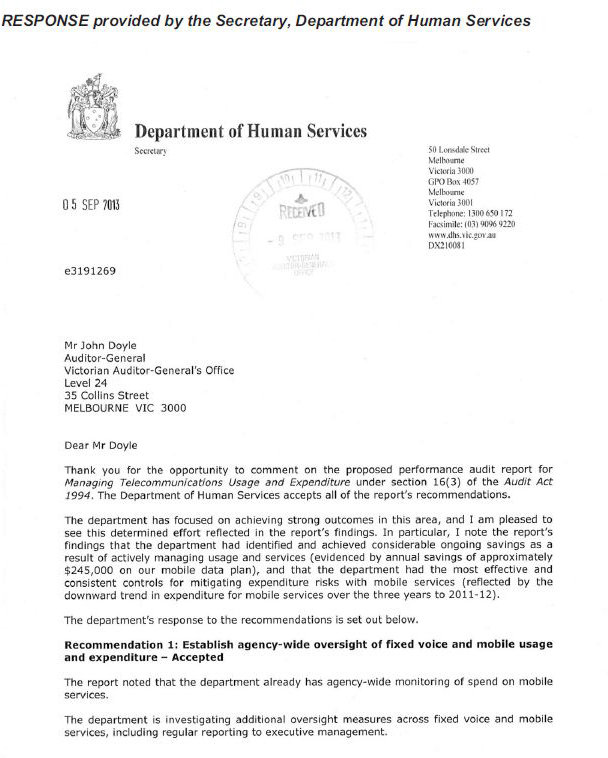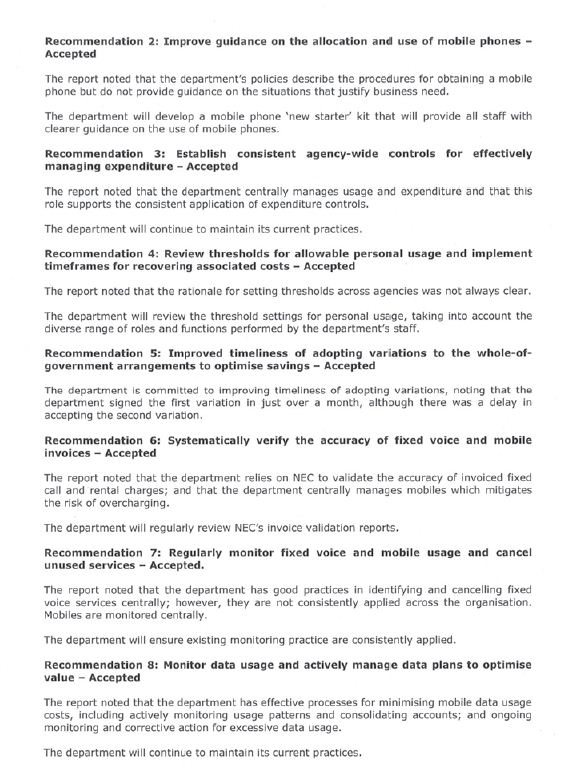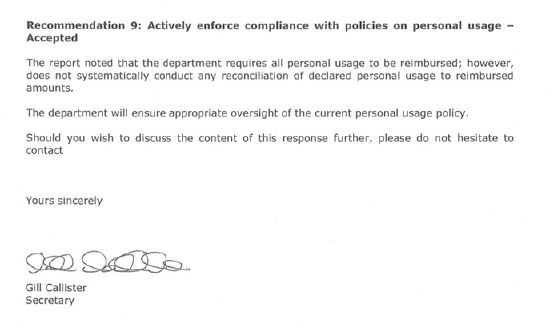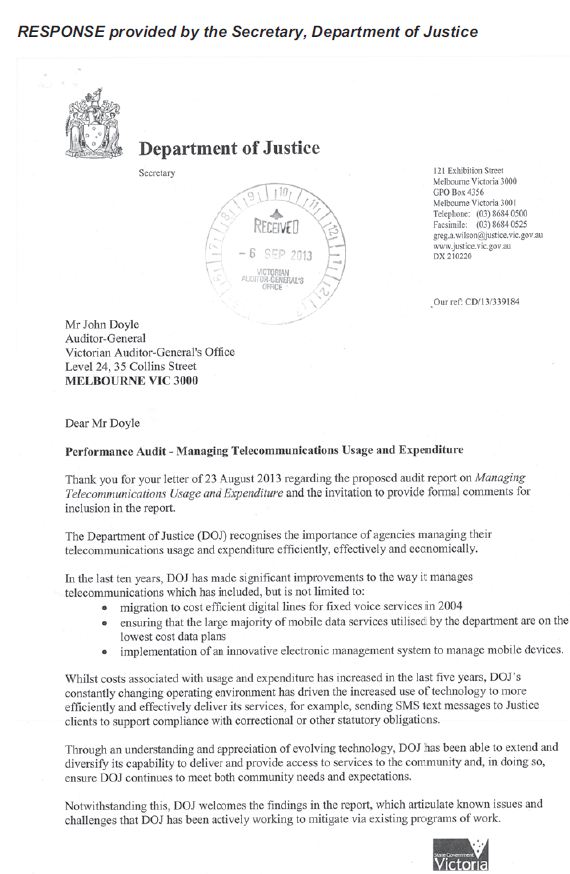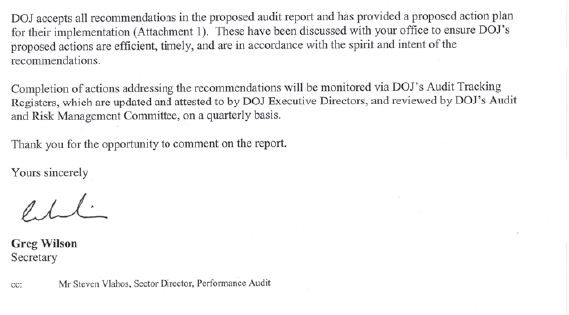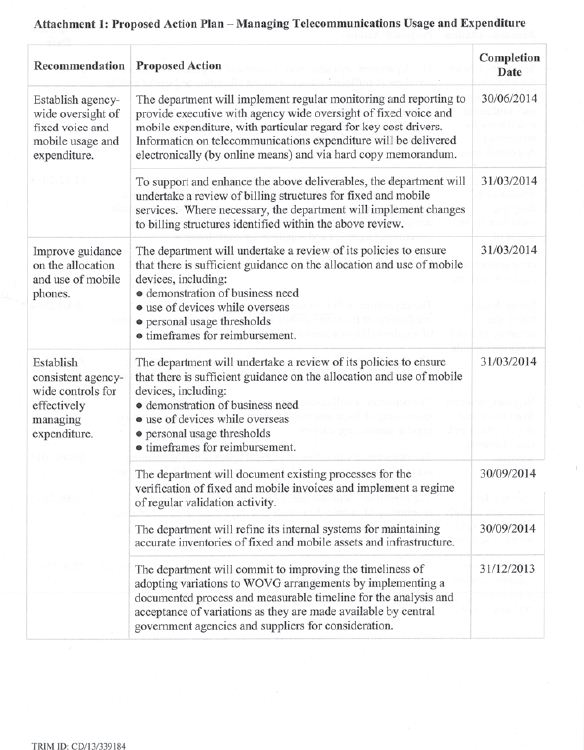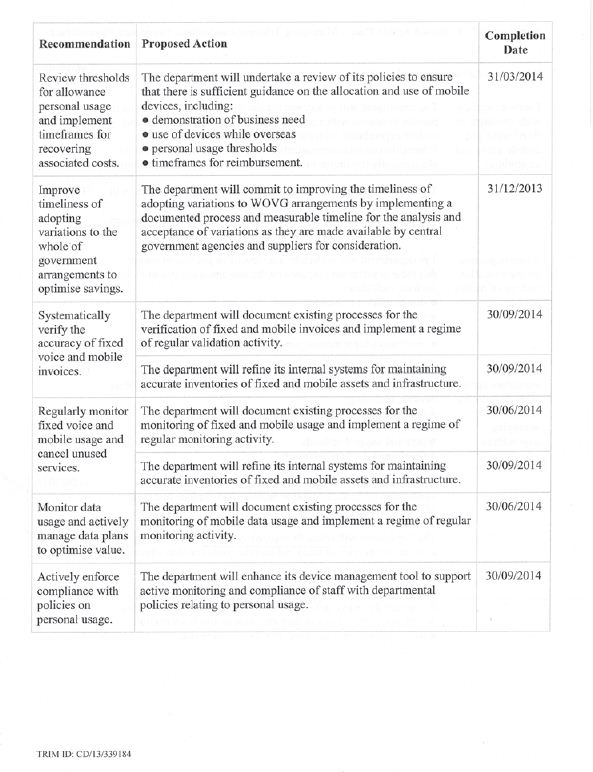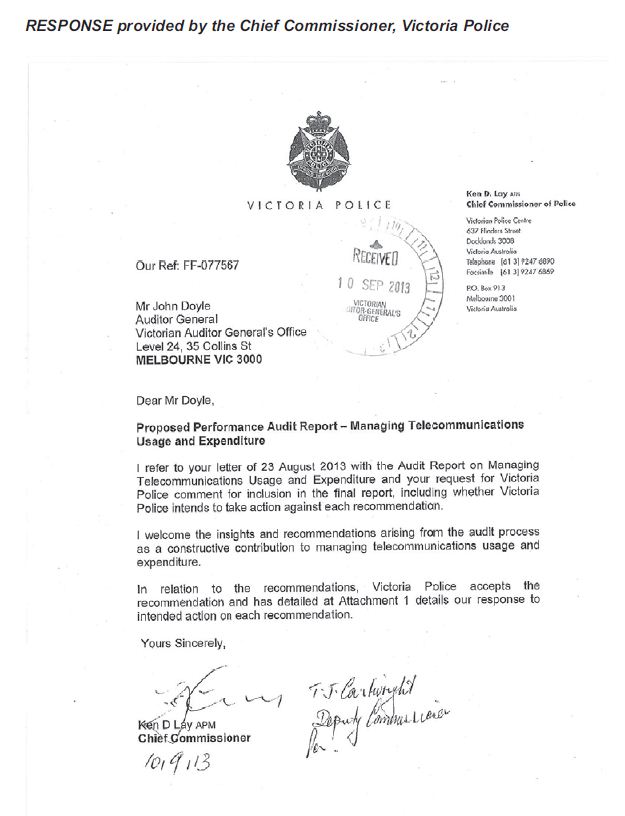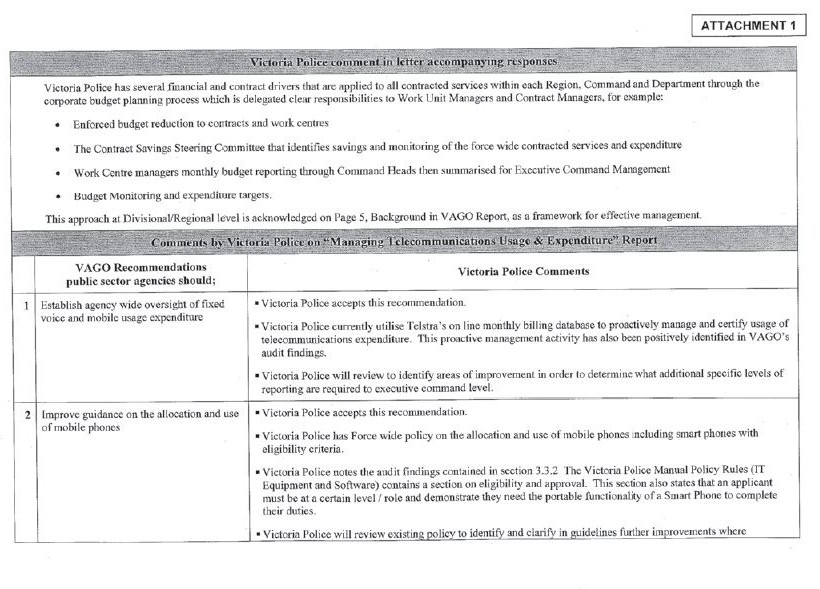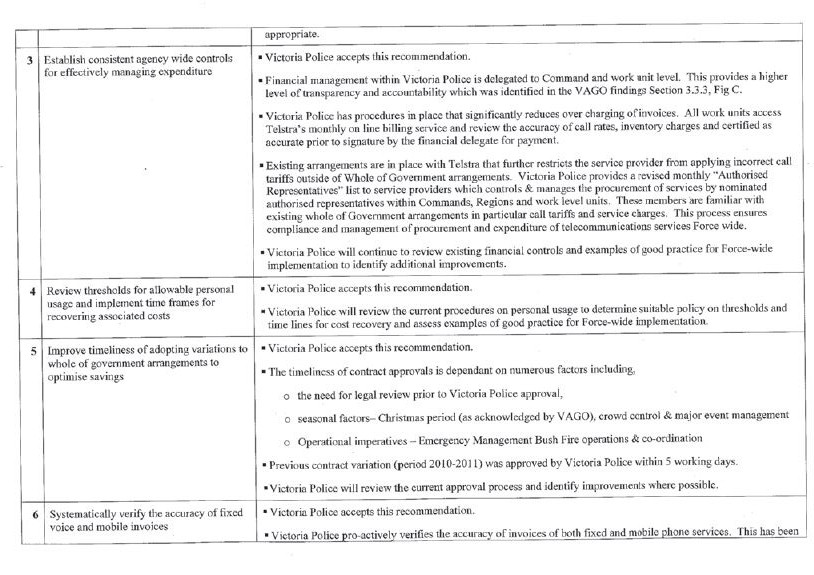Managing Telecommunications Usage and Expenditure
Overview
The agencies examined cannot be confident that they are effectively managing all aspects of their telecommunications usage and expenditure.
None of these agencies had sufficient organisation-wide controls to effectively manage the major drivers of both fixed voice and mobile expenditure—particularly call costs, mobile data use and line rental.
Weak central oversight, coupled with highly variable and devolved management arrangements within each agency means that, while there were isolated examples of good practice that produced material savings, it was not evident that these were being consistently applied throughout the organisation.
None of the agencies examined demonstrated regular whole-of-organisation oversight and monitoring of telecommunications usage and expenditure. Nor was it evident that executive management was systematically apprised of the effectiveness of related management controls and initiatives.
These weaknesses impede the capacity of each agency to identify and minimise waste and to fully leverage savings opportunities across the whole organisation.
Growing pressure on agency operating budgets to reduce administrative costs indicates that agencies need to take more focused and coordinated action to address these issues.
Managing Telecommunications Usage and Expenditure: Message
Ordered to be printed
VICTORIAN GOVERNMENT PRINTER September 2013
PP No 264, Session 2010–13
President
Legislative Council
Parliament House
Melbourne
Speaker
Legislative Assembly
Parliament House
Melbourne
Dear Presiding Officers,
Under the provisions of section 16AB of the Audit Act 1994, I transmit my report on the audit Managing Telecommunications Usage and Expenditure.
This audit assessed the effectiveness of telecommunications management and expenditure control practices of Victoria Police, the Department of Human Services and the Department of Justice.
While the report highlights examples of good practice, none of these agencies demonstrated sufficient organisation-wide controls to effectively manage all aspects of their fixed voice and mobile usage and expenditure.
The findings at the examined agencies provide the basis for making broader recommendations to all public sector agencies to improve their telecommunications management to reduce waste and achieve savings.
Yours faithfully

John Doyle
Auditor-General
18 September 2013
Auditor-General's comments
 Auditor-General |
Audit team Steven Vlahos—Sector Director Verena Juebner—Team Leader Fei Wang—Senior Manager Simone Meyer—Analyst Dallas Mischkulnig—Engagement Quality Control Reviewer |
Telecommunications are vital to the delivery of government services. Expenditure on telecommunications across all agencies has grown significantly in recent years—largely driven by the growing reliance on mobiles as communication devices.
There are growing pressures on state finances, including government priorities to improve the efficiency of agencies and reduce their administrative costs. This heightens the need for agencies to effectively manage and oversee this area of spend.
The day-to-day management of telecommunications in most agencies is often devolved across numerous business units. However, an effective whole‑of‑agency approach is critical for assuring:
- services are used appropriately by all staff
- rigorous expenditure controls are in place
- the organisation is minimising waste and leveraging full value from existing arrangements.
Achieving this requires clear policies for usage, management and expenditure control throughout the organisation. It also requires coordinated reporting to executive management that enables effective organisation-wide oversight and management of telecommunications services.
My audit has found encouraging examples of good practice at each examined agency that have produced useful savings. However, at an organisational level none of the agencies had sufficient controls, nor regularly monitored and reported to executive management on telecommunications usage and expenditure.
These weaknesses reduce assurance over the effectiveness of existing arrangements, and have impeded the management of key cost drivers including redundant services and excessive personal use. They have also prevented agencies from minimising waste and fully leveraging savings opportunities across the whole organisation.
The opportunities and issues highlighted by my audit offer valuable insights to other agencies on how to improve their management of telecommunications services. I have made a number of practical recommendations which pleasingly the examined agencies have accepted. I encourage all public sector agencies to similarly review their own arrangements to assure they are fully effective.
I would like to thank the staff in the Department of Human Services, Department of Justice and Victoria Police for their assistance and cooperation during this audit, and I look forward to receiving updates on their progress in implementing the recommendations.

John Doyle
Auditor-General
September 2013
Audit Summary
Background
Telecommunications services, in particular fixed voice and mobile phones, are essential to support the delivery of government services.
In 2004, the state executed contracts for the Telecommunications Purchasing and Management Strategy (TPAMS), comprising Telecommunications Carriage Services (TCS) agreements with approved providers. The agreements aim to deliver best value to agencies for fixed voice, mobile and data carriage services.
In 2011–12, total expenditure on fixed voice and mobile services through TCS arrangements was approximately $53 million. The agencies spending the most on these services in 2011–12 were:
- Victoria Police (VicPol)—approximately $6 million
- Department of Human Services (DHS)—approximately $3.5 million
- Department of Justice (DOJ)—approximately $3.5 million.
Recent statewide initiatives to improve the efficiency of the public sector heighten the need for agencies to establish effective arrangements to minimise administrative costs—including unnecessary expenditure on fixed voice and mobile services.
The audit examined the telecommunications management and expenditure control practices of VicPol, DHS and DOJ as they relate to fixed line and mobile phones. Specifically, it examined whether they are:
- effectively minimising waste and reducing the risk of overcharging
- effectively monitoring, detecting and managing inappropriate usage by employees
- actively managing contracts to assure value for money.
Conclusions
The agencies examined cannot be confident that they are effectively managing all aspects of their telecommunications usage and expenditure.
None of these agencies had sufficient organisation-wide controls to effectively manage the major drivers of both fixed voice and mobile expenditure—particularly call costs, mobile data use and line rental.
Weak central oversight, coupled with highly variable and devolved management arrangements within each agency means that, while there were isolated examples of good practice that produced material savings, it was not evident that these were being consistently applied throughout the organisation.
None of the agencies examined demonstrated regular whole-of-organisation oversight and monitoring of telecommunications usage and expenditure. Nor was it evident that executive management was systematically apprised of the effectiveness of related management controls and initiatives.
These weaknesses impede the capacity of each agency to identify and minimise waste and to fully leverage savings opportunities across the whole organisation.
Growing pressure on agency operating budgets to reduce administrative costs indicates that agencies need to take more focused and coordinated action to address these issues.
Findings
Expenditure trends and key cost drivers
The telecommunications expenditure trends of the three agencies examined provide important insights into the actions required to minimise waste and optimise value for money. Our analysis reveals that agencies stand to achieve ongoing savings and efficiencies by:
- making sure that they are being billed correctly by suppliers
- monitoring and minimising redundant fixed voice landlines so that they do not continue to incur unnecessary monthly fees
- accessing the best call and data rates on offer via the whole‑of‑government arrangements
- systematically identifying and recovering costs incurred for excessive personal use of mobile phones.
Of the three agencies examined, DHS had the most effective and consistent controls for mitigating expenditure risks with mobile services. This is reflected in part by the downward trend in expenditure for mobile services over the three years to 2011–12, and highlights the benefits of having consistent, agency-wide controls.
Establishing sound governance
None of the agencies examined monitor and report to executive management on whole-of-organisation fixed voice and mobile usage and expenditure. This impedes agency-wide oversight and reduces assurance that agencies are effectively minimising waste and optimising savings across the entire organisation. Additionally, none of the agencies had clarified the required minimum procedures and processes for effectively verifying invoices and minimising waste. This further reduces assurance of effective management across the entire organisation.
Agencies can increase savings by strengthening processes for reviewing and adopting negotiated improvements to rates and services within whole‑of‑government contracts. The average time taken by the agencies examined to adopt a nine-month variation was between two and three months, reducing the potential savings by up to a third. This represents potential lost savings to the state of up to $660 000 for mobile services alone across all the public sector agencies to which the contract applies.
Effectively controlling usage and expenditure
Inconsistent expenditure controls, coupled with inadequate attention to enforcing personal usage policies, reducing waste from redundant services and leveraging best value from whole‑of‑government agreements suggests that there is untapped savings potential across these agencies.
Shortcomings identified in the way that agencies manage their fixed voice and mobile services indicate that there is insufficient assurance that all are:
- effectively verifying invoices and reducing the risk of overcharging
- minimising their recurrent costs by rationalising redundant and/or inefficient landlines, extensions or devices
- setting consistent and reasonable limits for personal usage and have effective processes for recovering costs that exceed acceptable thresholds
- optimising value for money from contractual arrangements with suppliers by promptly taking advantage of reduced call rates and appropriate data plans.
Good practice was evident at VicPol in the way it verifies its fixed voice invoices. Specifically, the Eastern Region proactively monitors expenditure trends, which enables it to cost-effectively identify, investigate and resolve potential anomalies.
Additionally, DOJ was in the early stages of implementing a new electronic system for monitoring mobile spend across the department that has the potential to improve its oversight of mobile usage and expenditure.
The audit also found that VicPol and DHS had identified and/or achieved considerable ongoing savings as a result of actively managing their usage and services.
For example, VicPol has begun implementing an agency-wide initiative to remove redundant landlines and replace inefficient analogue lines with ISDN lines through which it is expected to achieve substantial recurrent savings in the order of $235 000 per year. Encouragingly, both DHS and DOJ had already migrated a high proportion of their fixed voice services to use more efficient ISDN lines.
Similarly, both VicPol and DHS have taken agency-wide action to better manage mobile data plans that has yielded considerable savings to date. By actively monitoring expenditure, aggregating accounts and switching to more cost-effective plans, DHS and VicPol have achieved annual savings of approximately $245 000 and $640 000 respectively since 2010.
These initiatives offer valuable insights into the potential savings to be gained from a more coordinated and effective whole-of-agency approach.
Recommendations
Public sector agencies should:
- establish agency-wide oversight of fixed voice and mobile usage and expenditure
- develop clear guidance on the allocation and use of mobile phones
- establish consistent, agency-wide controls for effectively managing expenditure
- review thresholds for allowable personal usage, and implement time frames for recovering associated costs
- promptly adopt variations to the whole-of-government agreements to optimise savings
- systematically verify the accuracy of fixed voice and mobile invoices
- regularly monitor fixed voice and mobile usage and cancel unused services
- regularly monitor data usage and actively manage data plans to optimise value
- actively enforce compliance with policies on personal usage.
Submissions and comments received
In addition to progressive engagement during the course of the audit, in accordance with section 16(3) of the Audit Act 1994 a copy of this report was provided to the Department of Human Services, the Department of Justice and Victoria Police with a request for submissions or comments.
Agency views have been considered in reaching our audit conclusions and are represented to the extent relevant and warranted in preparing this report. Their full section 16(3) submissions and comments are included in Appendix A.
1 Background
1.1 Introduction
1.1.1 Statewide telecommunications arrangements
Telecommunications services, particularly fixed voice and mobile phones, are essential to support the delivery of government services.
In 2004, the state executed contracts for the Telecommunications Purchasing and Management Strategy (TPAMS), comprising:
- Telecommunications Carriage Services (TCS) agreements for fixed voice and mobile call rates and services that aim to deliver best value
- the Victorian Office Telephony Services (VOTS) agreement for the provision of internal fixed voice telephony products and related services to the public sector.
The TCS arrangements were established in two tranches. Tranche 1 mainly involved the establishment of services for departments and statutory authorities and Tranche 2 focused on services for outer budget agencies such as local government. While these arrangements are optional, they are currently accessed by all agencies.
A separate tender process was administered specifically for Victoria Police (VicPol) due to its specialised operational requirements that could not be addressed under Tranche 1.
Figure 1A outlines the scope and service options currently available within these arrangements. It also indicates which of the audited agencies access them.
Figure 1A
Overview of TCS and VOTS agreements
Service |
Contract/supplier |
Scope and options |
Agencies |
|---|---|---|---|
Mobile carriage services |
TCS for mobiles:
|
Standard call rates and flexible data options, which are periodically reviewed. |
DHS, VicPol and DOJ—with Tranche 1 supplier |
Fixed voice carriage services |
TCS for fixed voice:
|
Standard call rates and line rental charges, which are periodically reviewed. |
DHS and DOJ—with Tranche 1 supplier VicPol—sole recipient of Telstra services |
Telephony equipment and services for fixed voice |
VOTS
|
Managed telephone network for fixed voice and related services, including:
|
DHS Central and DOJ Central. |
Source: Victorian Auditor-General's Office.
The central offices of the Department of Human Services (DHS) and the Department of Justice (DOJ) are party to the VOTS contract, but some of the DOJ and DHS regions use other providers to manage and maintain their fixed voice infrastructure, reflecting the differing needs and complex management arrangements that can exist within some agencies. VicPol owns its internal fixed voice telephone network infrastructure and does not use VOTS.
The Department of Treasury and Finance (DTF) was responsible for managing TPAMS and associated whole‑of‑government agreements with suppliers prior to the recent machinery of government changes announced in April 2013. On 1 July 2013, this responsibility was transferred to the Department of State Development, Business and Innovation (DSDBI).
1.2 Expenditure on fixed voice and mobile services
In 2011–12, total expenditure on fixed voice and mobile services through TCS arrangements was approximately $53 million. The agencies spending the most on these services in 2011–12 were:
- VicPol—approximately $6 million
- DHS—approximately $3.5 million
- DOJ—approximately $3.5 million.
Figure 1B shows that total expenditure on these services through TCS arrangements has grown significantly across the Victorian public sector over the five years to 2012. While expenditure on fixed voice has remained relatively steady, at around $30 million a year, the most significant expenditure growth has occurred in the mobile sector, which has increased almost 70 per cent—from nearly $14 million in 2008 to $23.5 million in 2012.
Figure 1B
Whole-of-government expenditure on fixed voice and mobile carriage services,
2007–08 to 2011–12
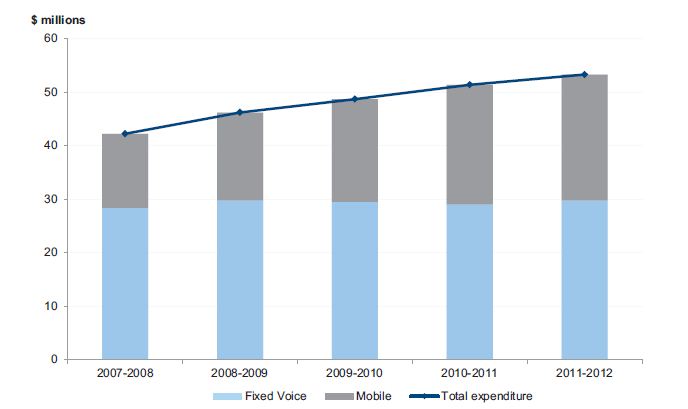
Source: Victorian Auditor-General's Office from data supplied by DTF.
1.2.1 The importance of effective management
Recent statewide initiatives to improve the efficiency of the public sector heighten the need for agencies to establish effective arrangements to minimise administrative costs—including unnecessary expenditure on fixed voice and mobile services.
The government's 2010 Better Financial Management Plan sets a savings target of $1.6 billion over five years from 2010–11 to 2014–15. It aims to achieve 45 per cent of these savings by reducing departmental running costs by $722 million. These savings targets illustrate the importance of effectively managing this spend by controlling costs, reducing waste and driving better value from whole‑of‑government arrangements.
The Better Services Implementation Taskforce and the Sustainable Government Initiative also create strong imperatives for agencies to minimise waste by effectively managing these services. Additionally, recent machinery of government changes—including periodic changes to staffing profiles, organisational structures and service delivery models—provide further ongoing imperatives to agencies to continuously review their telecommunications expenditure and associated management arrangements.
1.2.2 Agency roles and opportunities to leverage savings
Each agency is responsible for managing its use of and expenditure on fixed voice and mobile telecommunications services in a way that:
- effectively controls the risk of inappropriate expenditure
- is efficient—minimising waste and reducing the risk of being overcharged
- is economic—making best use of aggregated purchase agreements.
Opportunities exist for agencies to optimise value for money by making best use of the whole‑of‑government arrangements. Options include:
- monitoring and managing mobile data usage to assure the organisation is leveraging the most economic plan
- acting quickly to sign on to improved rates and services negotiated by DTF—now administered by DSDBI—to take full advantage of new savings opportunities.
1.3 Overview of the audited agencies
The mix of telecommunication services at each examined agency varies according to its business needs and organisational structure. For example, agencies with a strong regional presence, or where staff often carry out their duties outside the office or outside of normal business hours will have a greater need for mobile phones. In contrast, agencies where activities are centralised in one or a few locations, and where staff work mainly during normal business hours are more likely to be able to rely mainly on fixed voice services.
Each of the audited agencies has a strong regional presence:
- DHS has 11 000 staff who deliver services through 17 local areas, for which the administration support comes from four divisions created in late 2012.
- DOJ employs 7 000 people working across 141 sites to provide services to the community 24 hours a day, 365 days a year, including the management and operation of the state's correctional services system.
- VicPol employs more than 16 000 people working from over 500 locations across the state, divided into four regions to provide support to the community 24 hours a day, 365 days of the year. Its operations also extend to interstate and offshore sites.
Figure 1C shows a summary of the total number of fixed voice landlines and mobile devices currently managed by the examined agencies.
Figure 1C
Number of landlines and mobile devices as at 30 June 2013
Agency |
Landlines |
Mobile voice (b) |
Mobile data(c) |
|---|---|---|---|
DHS |
(a) |
4 280 |
1 324 |
DOJ |
2 316 |
1 251 |
1 703 |
VicPol |
3 406 |
2 635 |
2 038 |
(a) DHS could
not provide data for the whole organisation.
(b) 'Mobile
voice' includes voice-only mobile phones.
(c) 'Mobile
data' includes services with a data plan, including Next G wireless modems,
smartphones and iPads.
Source: Victorian
Auditor-General's Office from data supplied by the audited agencies.
1.4 Framework for effective management
In most agencies, the day-to-day management of telecommunication services is devolved to individual business units, divisions and/or regional offices that must pay for these services out of their own budget.
Therefore, an effectively implemented, organisation-wide management framework is essential for assuring executive management that:
- telecommunication services are being used appropriately by staff throughout the organisation in accordance with established policies
- rigorous expenditure control practices that effectively minimise overcharging and inappropriate usage are developed and consistently applied by all business units
- the organisation as a whole is actively managing its usage and expenditure to minimise waste and optimise value from existing contractual arrangements.
Consistent and rigorous application of this framework across the entire organisation requires establishing clear responsibilities at the divisional and or regional level. It also requires mechanisms for coordinated reporting by divisions or regions to executive management that enable effective organisational oversight and management of these services.
Figure 1D further outlines the framework and the various management responsibilities and activities at different levels of the organisation.
Figure 1D
Framework for effective management of telecommunications services
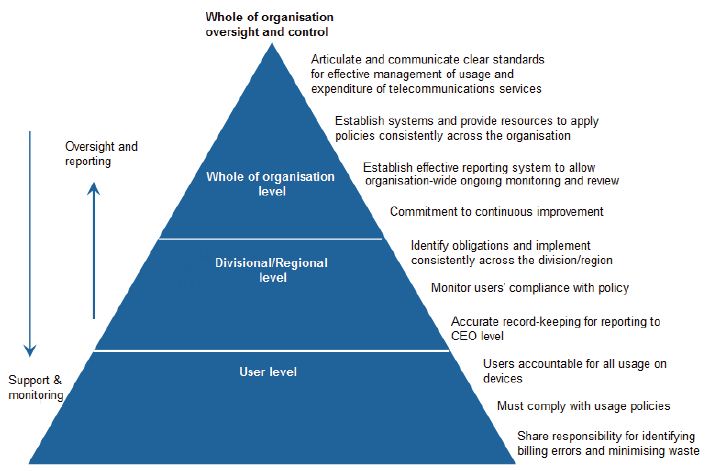
Source: Victorian Auditor-General's Office.
1.5 Audit objectives and scope
The audit examined whether agencies effectively manage their use of and expenditure on fixed voice and mobile telecommunications. Specifically, it examined whether agencies are effectively:
- minimising waste and reducing the risk of overcharging
- monitoring, detecting and managing inappropriate usage by employees
- managing contracts to assure value for money.
The audit examined the telecommunications management and expenditure control practices of VicPol, DOJ and DHS. These agencies were selected on the basis of the materiality of their annual expenditure.
1.6 Audit method and cost
The audit was conducted under section 15 of the Audit Act 1994 and in accordance with the Australian Auditing and Assurance Standards.
Pursuant to section 20(3) of the Audit Act 1994, unless otherwise indicated, any persons named in this report are not the subject of adverse comment or opinion.
The total cost was $350 000.
1.7 Structure of the report
Part 2 analyses past expenditure on fixed voice and mobile services for the audited agencies.
Part 3 assesses the adequacy of agencies' governance arrangements for effectively managing telecommunications usage and expenditure.
Part 4 examines whether agencies have effectively mitigated the risks of overcharging by suppliers and minimised waste.
2 Expenditure trends and key cost drivers
At a glance
Background
Sound analysis of telecommunications expenditure provides important insights into the actions required to minimise waste and optimise value for money.
Conclusion
Analysis of agency telecommunications use and expenditure highlights the importance of effectively managing call, data use and line rental costs for minimising both fixed voice and mobile expenditure. The Department of Human Services (DHS) has the most effective agency-wide controls for mobiles, and this is reflected in its declining expenditure for this service over the three years to 2011–12.
Deficiencies identified in fixed voice and mobile cost controls at the Department of Justice (DOJ) mean that it cannot be confident that the increasing trend in expenditure for both services is fully justified, and that the risks of supplier overcharging and waste from unnecessary lines have been effectively mitigated.
Findings
- DHS' expenditure on mobiles shows the strongest decline (29 per cent), which can be attributed in part to the effectiveness of its centralised management of its mobile voice and data services. However, deficiencies in its fixed voice management mean that it cannot be confident that its expenditure on this service does not include waste.
- Victoria Police has been effective in controlling mobile data costs since 2010–11 despite increasing numbers of services. It expects to yield future savings in its fixed voice expenditure from agency-wide initiatives to rationalise landlines.
- DOJ is the only agency examined with increasing expenditure on both fixed voice and mobile services. It also has the weakest management controls.
2.1 Introduction
Regular analysis by agencies of their telecommunications expenditure is essential for its effective management. Sound analysis of billing data provides important insights into usage and expenditure levels and the actions that may be required to minimise waste and optimise value for money.
This part of the report examines the expenditure trends and associated cost drivers of fixed voice and mobile services for each of the three audited agencies. While the data for Victoria Police (VicPol) and the Department of Justice (DOJ) cover a five-year period to 2011–12, only data from 2009–10 is presented for the Department of Human Services (DHS), reflecting the timing of its establishment following the 2009 machinery of government changes.
2.2 Conclusion
Analysis of agency telecommunications use and expenditure highlights the importance of effectively managing call, data use and line rental costs for minimising both fixed voice and mobile expenditure.
DHS has the most effective agency-wide controls for mobiles and this is reflected in its declining expenditure for this service over the three years to 2011–12.
However, identified deficiencies in fixed voice and mobile cost controls at DOJ mean that it cannot be confident that the consistent upward trend in expenditure evident for both services is justified, and that the risks of supplier overcharging and waste from unnecessary lines have been effectively mitigated.
2.3 Analysis of expenditure trends
2.3.1 Introduction
The following sections provide an overview of the expenditure trends and related drivers for each of the three audited agencies. Specifically, this analysis:
- shows how much agencies have spent in the past five years, including how their expenditure is trending for fixed voice and mobiles
- gives an insight into expenditure on different cost components for fixed voice and mobiles, identifying the key risk areas agencies should focus on to best manage expenditure
- provides an indicator of how well agencies are managing their expenditure and reducing waste.
Factors influencing expenditure
It is important to note that total expenditure on fixed voice and mobile services can be influenced by several factors, including:
- usage—which should be comprised of mainly business use and minor personal use
- changing unit costs—negotiated improvements to call rates and service levels in recent years have progressively reduced the unit cost of calls, data and related services
- potential waste—weak management and payment controls can lead to unnecessary expenditure due to undetected overcharging and excessive personal use, ongoing payment for redundant services, or failure to leverage best value plans within Telecommunications Carriage Services (TCS) agreements.
These factors indicate that agencies can benefit from focusing attention on:
- monitoring whether suppliers are overcharging and that the agency is not paying for services it does not need
- leveraging improved unit costs by promptly adopting renegotiated agreements
- reducing excessive personal use and enforcing rules around reimbursement.
2.3.2 Expenditure on fixed voice
Figure 2A demonstrates the indexed expenditure per agency on fixed voice.
Figure 2A
Indexed
expenditure on fixed voice services by DHS, DOJ and VicPol(a)
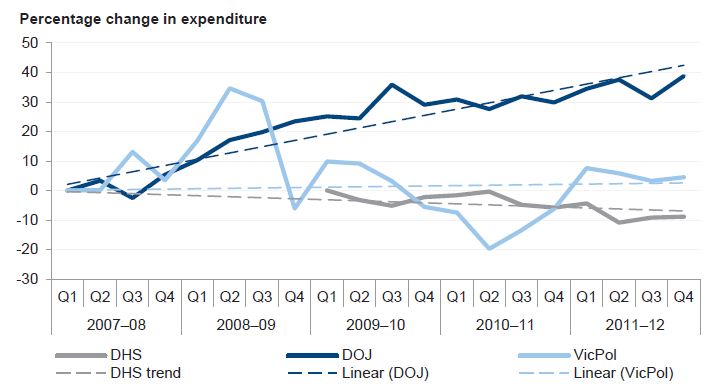
(a) Expenditure
for DOJ and VicPol has been indexed relative to the spend each incurred in Q1
2007–08. For DHS it has been indexed relative to Q1 2009–10 reflecting the
timing of its establishment following the 2009 machinery of government changes.
Source: Victorian Auditor-General's
Office from data supplied by DTF.
Figure 2A shows that:
- DOJ experienced the most significant increase in expenditure on fixed voice services relative to DHS and VicPol, growing by 39 per cent since 2007–08
- VicPol's expenditure also increased, but by a much lesser overall amount of 4.5per cent from 2007–08 to 2011–12. However, it also exhibited significant and greater variation in expenditure compared with the other agencies, reflecting the more dynamic nature of policing and emergency services
- DHS was the only audited agency to show a decrease in expenditure on fixed voice—by 9 per cent since 2009–10.
These trends can be attributed in part to the effectiveness of agency management practices as well as changes to fee structures within the TCS agreements.
Figures 2B, 2C and 2D further examine the cost drivers underpinning the expenditure trends for DHS, DOJ and VicPol.
Figure 2B
Expenditure on fixed voice services by DHS
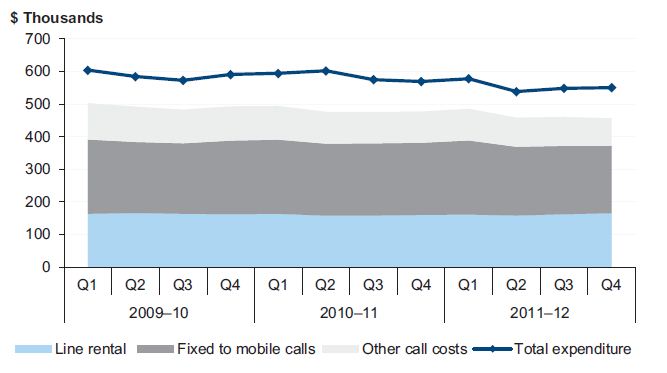
Note: 'Other
call costs' consists of local calls, national calls and international calls.
Source: Victorian
Auditor-General's Office from data supplied by DTF.
Figure 2B shows that DHS' line rental costs have remained steady over the three-year period and that the 9 per cent reduction in total expenditure since 2009–10 is mainly due to a decline in call costs, particularly costs associated with fixed voice to mobile calls.
Weaknesses in DHS' invoice verification processes and actions to minimise waste from unnecessary line rental costs suggest that the downward trend is more likely due to improved call rates and services rather than consistent and effective organisation‑wide management practices. These issues are discussed further in Parts 3 and 4 of this report.
Figure 2C
Expenditure
on fixed voice services by DOJ
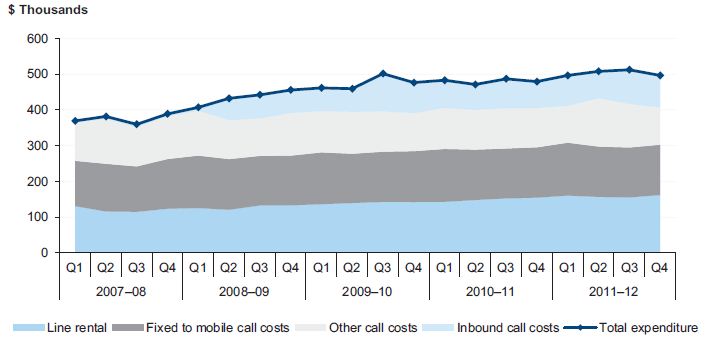
Note: 'Other
call costs' consists of local calls, national calls and international calls.
Source: Victorian
Auditor-General's Office from data supplied by DTF.
DOJ's expenditure on fixed voice services rose by 39 per cent during the five years to 2011–12. This was the most significant increase in total expenditure for this service across the three audited agencies.
DOJ advised that, during the time period examined, a significant shift in the complexity of its operations resulted in increased fixed voice services and this is likely to have contributed, in part, to the increased cost. Figure 2C confirms that the upward trend in total expenditure can be linked to a corresponding growth in inbound calls.
However, it is not evident that this upward trend is attributable to increased business usage alone. Specifically, weak payment controls and processes for rationalising unnecessary landlines across DOJ mean that the risks of overcharging and waste have not been effectively mitigated.
Deficiencies in the way DOJ manages its fixed voice services are discussed further in Parts 3 and 4 of this report.
Figure 2D
Expenditure on fixed voice services by
VicPol
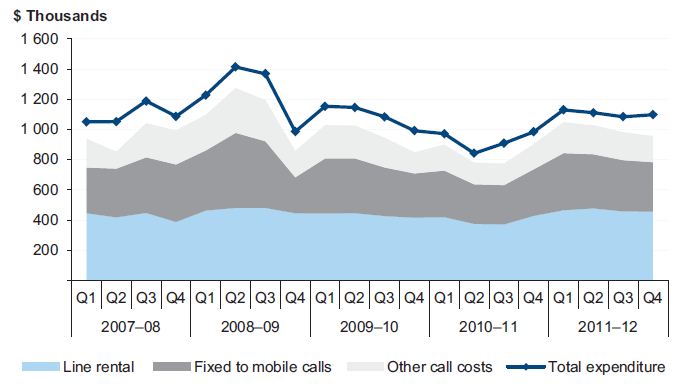
Note: 'Other
call costs' consists of local calls, national calls and international calls.
Source: Victorian Auditor-General's Office from data
supplied by DTF.
Figure 2D shows that variations in expenditure for VicPol are largely driven by fluctuations in call costs, particularly around bushfire and flood periods, reflecting the dynamic nature of policing and emergency management.
VicPol's effective processes for invoice verification means that its greatest opportunities for future savings relate to line rationalisation. VicPol has identified significant savings potential in this regard and is implementing agency-wide action to leverage these opportunities. These activities are discussed further in Part 4 of this report.
2.3.3 Expenditure on mobile services
Figure 2E shows the trend in indexed expenditure on mobiles per agency.
Figure 2E
Indexed expenditure on mobile services
by DHS, DOJ and VicPol(a)
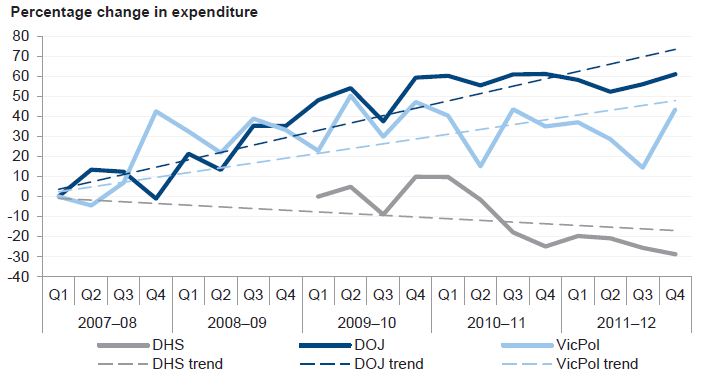
(a) Expenditure for DOJ and VicPol has been
indexed relative to the spend each incurred in Q1 2007–08. For DHS it has
been indexed relative to Q1 2009–10, reflecting the timing of its establishment
following the 2009 machinery of government changes.
Source: Victorian
Auditor-General's Office from data supplied by DTF.
Figure 2E highlights considerable difference in expenditure patterns across the audited agencies. Specifically, it shows that:
- expenditure by VicPol and DOJ increased significantly, by 45 per cent and 61percent respectively, over the five-year period to 2011–12
- DHS' expenditure has decreased sharply, by 29 per cent, since 2009–10.
The following sections further examine the main drivers of these trends.
Figure 2F
Expenditure on mobile services by DHS,
2009–10 to 2011–12
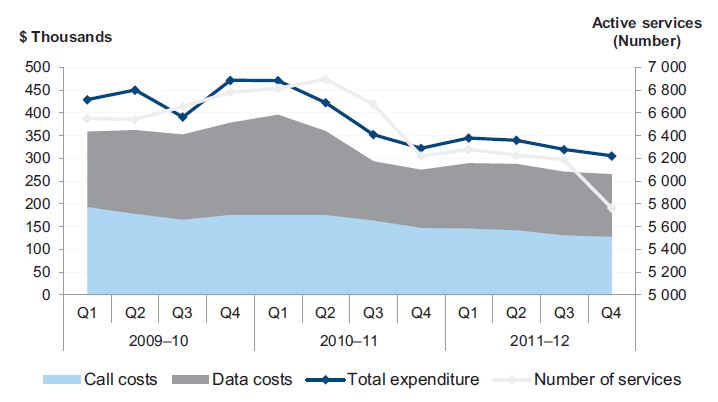
Source: Victorian Auditor-General's Office from data supplied by DTF.
Figure 2F shows that DHS' overall expenditure on mobile services has fallen sharply since early 2010–11. This fall can be attributed to the significant reduction in the number of mobile services issued over the same period, as well as active management of data plans to optimise value. DHS' more effective invoice verification controls and its centralised oversight and management of mobile data services have contributed to this result.
These practices are discussed further in Parts 3 and 4 of this report and provide useful insights into the benefits of effective telecommunications management arrangements.
Figure 2G
Expenditure on mobile services by DOJ,
2007–08 to 2011–12
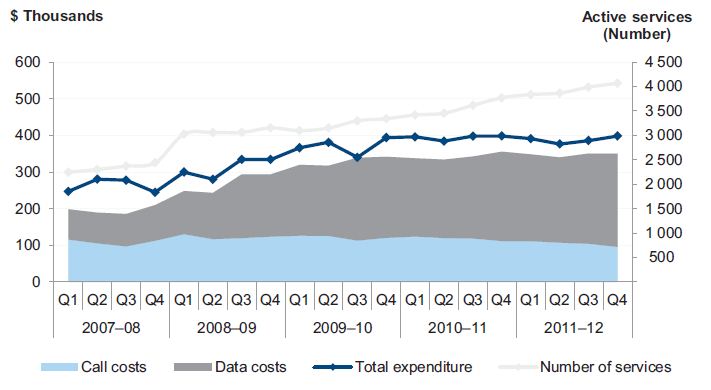
Source: Victorian Auditor-General's Office from data supplied by DTF.
Expenditure on mobiles by DOJ has increased by 61 per cent during the five years from 2007–08 to 2011–12.
While DOJ's call costs have remained relatively steady and decreased marginally during 2011–12, the overall increase in expenditure has been driven by rising data costs. In particular, data costs increased sharply in the third quarter of 2008–09 and continued on an upward trend over the period to reach around $250 000 per quarter in 2011–12. This rise is also reflected in the increasing number of mobile services over the same period.
DOJ advised that it is using telecommunications technology for more efficient and targeted service delivery to the community. While it acknowledges this has contributed to increased telecommunications cost, it advised that there are significant efficiencies and positive outcomes to be gained.
However, shortcomings in DOJ's approach to managing its mobile services and related expenditure mean that it cannot be confident that this significant upward trend reflects the most economical use of mobile services, or that it is effectively leveraging savings opportunities.
Figure 2H
Expenditure on mobile services by
VicPol, 2007–08 to 2011–12
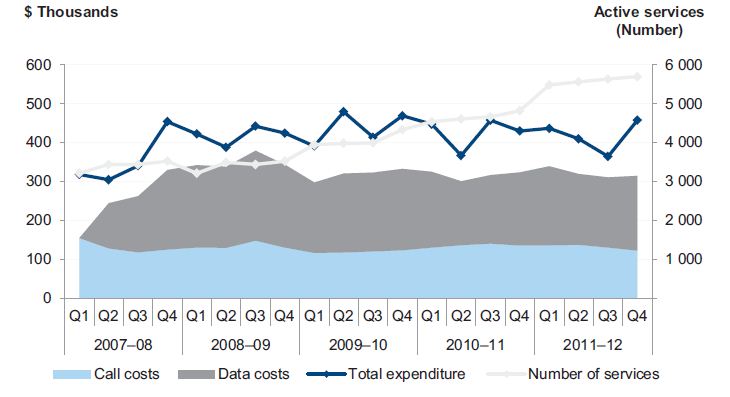
Source: Victorian Auditor-General's Office from data supplied by DTF.
Figure 2H shows that VicPol's total expenditure on mobile services grew by 47 per cent between the beginning of 2007–08 and the fourth quarter of 2009–10, driven mainly by an almost 80 per cent increase in data costs over the same period.
VicPol has since moderated this expenditure growth despite the continuing upward trend in the number of issued mobile services. The resulting savings can be attributed largely to recent successful force-wide initiatives to minimise waste by reducing unused services and consolidating mobile accounts.
These initiatives are discussed further in Part 4 and offer valuable insights into the effective management of mobile data services.
2.4 Main cost drivers and key risk areas
2.4.1 Summary of key cost drivers
The above analysis highlights the main cost drivers and related management practices that offer the greatest potential for minimising expenditure and waste. Specifically, it shows that:
- for mobile expenditure—call charges and data use make up the key cost drivers, with data costs being the main contributor. This illustrates the importance of managing these costs effectively, as they can escalate if left uncontrolled
- for fixed voice expenditure—calls to mobiles and line rental are the most significant cost drivers.
The high number of fixed calls to mobiles reflects the proliferation and preference for mobile phones as communication devices. In this context, inefficient or redundant landlines are likely to represent the greatest source of waste for fixed voice expenditure.
2.4.2 Savings opportunities
These results indicate that agencies stand to achieve the greatest ongoing savings and efficiencies by making sure that they are:
- being billed correctly by suppliers, and accessing the best call and data rates on offer via the whole‑of‑government arrangements
- actively monitoring data usage, and leveraging the best plan options available to optimise value for money
- monitoring and minimising redundant fixed voice landlines so that they do not continue to incur unnecessary monthly fees
- systematically identifying and recovering any costs incurred for excessive personal use of mobile phones.
DHS' success in managing mobile expenditure highlights the benefits of consistent, agency-wide controls.
The following Parts further discuss the performance of each examined agency in relation to the above.
3 Establishing sound governance
At a glance
Background
Sound governance of telecommunications usage and expenditure is essential to effectively minimise waste and leverage organisation-wide savings opportunities.
Conclusion
While the agencies examined have largely adequate guidance on telecommunications usage, none have established consistent organisation-wide controls or oversight to effectively mitigate the risk of overcharging and waste.
Findings
- None of the agencies examined monitor and report to executive management on organisation-wide fixed voice and mobile usage and expenditure.
- Thresholds for allowable personal usage varied considerably across the agencies examined and none set time frames for reimbursement, impeding timely and effective cost recovery.
- Substantial scope exists for agencies to better leverage new savings opportunities by promptly signing on to variations to the whole-of-government agreements.
Recommendations
Public sector agencies should:
- establish agency-wide oversight of fixed voice and mobile usage and expenditure
- develop clear guidance on the allocation and use of mobile phones
- establish consistent, agency-wide controls for effectively managing expenditure
- review thresholds for allowable personal usage, and implement time frames for recovering associated costs
- promptly adopt variations to the whole‑of‑government agreements to optimise savings.
3.1 Introduction
To effectively manage fixed voice and mobile services, agencies need to establish:
- whole-of-organisation oversight and monitoring of fixed voice and mobile usage and expenditure
- processes to effectively mitigate the risks of supplier overcharging, wasted expenditure and inappropriate usage, consistently across the organisation
- mechanisms to quickly leverage savings opportunities from periodical variations to the Telecommunications Carriage Services (TCS) agreements with suppliers.
The need to control inappropriate or excessive personal usage is more important for mobiles phones than it is for fixed voice services. This is because:
- mobiles usage and expenditure is growing faster across the public sector than expenditure on fixed voice; in particular, costs associated with use of mobile data have increased rapidly
- phones are usually allocated to individuals who may take the phone home, thereby increasing the potential for usage outside work hours
- mobiles may be taken overseas, where international roaming charges can apply.
Corporate policies, therefore, need to clarify the business rules for allocating mobile phones, the thresholds for reasonable personal usage and the requirements for reimbursement, and provide guidance on usage when travelling overseas.
3.2 Conclusion
None of the agencies could demonstrate effective agency-wide oversight of both fixed voice and mobile usage and expenditure.
While each of the agencies examined has mostly adequate policies guiding telecommunications usage, none has established consistent, organisation-wide controls to effectively mitigate the risk of overcharging, waste and inappropriate usage for both fixed voice and mobile services.
There is substantial scope for agencies to better leverage new savings opportunities from periodic improvements to TCS arrangements by promptly signing on to revised agreements.
These shortcomings mean that agencies cannot be confident that they are effectively and efficiently managing all aspects of their telecommunications usage and expenditure.
3.3 Agency-wide oversight of usage and expenditure
None of the agencies examined can demonstrate that there is effective organisation‑wide oversight of fixed voice and mobile usage and expenditure. This reduces assurance that they are effectively minimising waste and optimising savings across the entire organisation.
Analysing expenditure trends across the organisation helps identify potential billing and usage issues and the targeting of high-cost areas. Periodic reporting on usage and expenditure to executive management also enables them to make informed decisions on the actions necessary to leverage savings opportunities.
Figure 3A outlines two examples where the Eastern Region of Victoria Police (VicPol) and the central office of the Department of Human Services (DHS) used billing data to increase visibility and control over telecommunications expenses. While neither example involved comprehensive reporting to executive management for the whole organisation, they nevertheless demonstrate the value and potential of this information for strengthening agency-wide oversight and management of telecommunications usage and expenditure.
Figure 3A
Monitoring, analysing and reporting
usage and expenditure
VicPol Eastern Region has one central contact that uses the monthly billing data to proactively monitor the region's fixed voice and mobile usage and expenditure, and report this to its senior regional management on a monthly basis. Through this reporting, the region:
- can analyse expenditure across the region by business unit
- has a good grasp of its historical spending profile and trends, including factors that influence seasonal variations, such as fire or floods
- can easily identify spending anomalies that are outside the expected ranges, which are then investigated as potential increases in unauthorised usage or supplier overcharging
- is able to demonstrate an overall reduction in landline costs and provide assurance to senior management that services are being effectively managed across the region.
These processes provide valuable insights to the regional leadership group. However, it is not evident that this practice extends beyond the region to provide VicPol executive management with assurance over the effectiveness of usage and expenditure controls across the entire organisation.
Further, as VicPol has several organisational drivers that aim to identify savings or enforce budget reductions, effective reporting mechanisms that allow whole‑of‑agency analysis of telecommunications usage expenditure would help to further identify and achieve potential savings.
DHS has a central business unit that monitors agency‑wide spending on mobile services. This allowed DHS to identify rising mobile data costs as an issue in 2010, which led to an agency‑wide initiative to better manage data plans. Tracking of overall expenditure following implementation of this initiative also allowed the unit to assess the value and positive impact of the project.
However, it is not evident that the information monitored by the unit is reported to executive management.
Source: Victorian Auditor-General's Office.
The Department of Justice (DOJ) advised that it monitors its fixed voice and mobile usage and expenditure through the use of various management tools. However, as the practice was not clearly documented, it was not evident that it systematically occurred.
DOJ advised it intends to more regularly undertake and formally document its monitoring processes within the next 12 months. Encouragingly, it is also in the early stages of implementing a new computerised management tool across the department that has the potential to improve whole‑of‑agency oversight of mobile usage and expenditure.
3.3.1 Establishing controls to minimise inappropriate usage
Each agency has adequate policies that clarify the minimum requirements for acceptable usage of fixed voice and mobile devices. These policies reinforce that these devices are primarily for business use and that only minimal personal usage in emergency or urgent situations is allowed.
However, agencies could better control usage by:
- improving guidance on what constitutes a demonstrable business need for allocating mobile phones to staff
- setting clear thresholds for allowable personal usage, and establishing sound procedures for effective enforcement
- providing guidance on appropriate mobile usage when on international travel.
Guiding the allocation of mobile phones
Providing clear guidance on the allocation of mobile phones helps to minimise inappropriate usage by ensuring that only those staff with legitimate business needs receive a device.
Each of the agencies requires the allocation of mobiles to be supported by a demonstrable business need, and has established related approval processes. However, only DOJ provides clear guidance to staff on the circumstances in which mobile phones can be supplied. For example, its policies clarify that smart phones are only to be issued to those who require constant access to their email or calendar.
While VicPol's and DHS' policies describe the procedures and approval processes for obtaining a mobile phone, they do not provide similar guidance on the kinds of situations that justify business need. VicPol Eastern Region is currently drafting new instructions that will include a list of decision points to help guide this assessment.
Reviewing thresholds for allowable personal usage
Most agencies accept that staff may sometimes need to use communication devices for personal use in emergency or urgent situations. To mitigate the risk of excessive or inappropriate personal usage, agencies need to set reasonable thresholds, beyond which costs must be repaid to the agency within set time frames.
Thresholds for allowable personal usage varied considerably across the agencies examined and, within VicPol, across different business units. Further, none of the agencies set time frames for reimbursement, impeding timely and effective cost recovery.
Figure 3B outlines the key approaches for declaring personal usage and setting thresholds for reimbursement by the agencies audited.
Figure 3B
Agency rules for declaring and reimbursing personal usage
Agency |
Declaration requirements |
Agency-wide limit |
Dollar amount |
|---|---|---|---|
DHS |
Applies only to staff with personal usage, otherwise no requirement |
Yes |
$0—All personal usage must be reimbursed |
DOJ |
Applies to all staff, even if personal usage is $0 |
Yes |
Varies—depends on personal usage as a percentage of total bill |
VicPol |
No agency-wide rule |
No—up to each region/division |
Varies—i.e. Eastern Region has no limit, State Emergencies and Security Department sets $20 limit |
Source: Victorian Auditor-General's Office.
DHS has the strictest policy, which requires all users to reimburse any personal usage. DOJ, on the other hand, requires all users to declare monthly personal usage but has complex rules for working out the amount that must be reimbursed.
Specifically, where total mobile expenditure for the month exceeds $20, users must work out whether personal usage is below or above 25 per cent, with only the latter requiring reimbursement. This situation can lead to inconsistencies and inequity in reimbursements, where relatively low amounts of personal usage must be repaid in full, but where comparatively much higher amounts do not, by virtue of the fact that they are less than 25 per cent of the total bill.
DOJ advised that it developed the process as a practical measure, taking tax implications into account and reflecting the need to strike a balance between assuring accountability for personal usage and minimising the administrative costs of enforcing compliance.
VicPol is the only agency audited that does not set agency-wide limits for reasonable personal usage and instead leaves that decision to the regions and departments. The CBD-based State Emergencies and Security Department (SESD) within VicPol sets a limit of $20 for reasonable personal usage per month and the responsibility to track reimbursements is decentralised to each business unit within SESD.
On the other hand, VicPol's Eastern Region does not set limits for reasonable personal usage, which reduces accountability and the region's capacity to effectively recover costs. The region advised that this is due to the front-line policing role and the fact that mobile phones in the region are generally issued to work stations rather than individuals. However, it also advised that it is considering implementing thresholds for reasonable personal usage in future, which will help to identify instances of excessive personal usage and whether reimbursed amounts are accurate.
The rationale for existing thresholds across the audited agencies is not always clear, indicating a need to review the basis upon which they are established. Further, all agencies examined need to set time frames for reimbursement, to allow timely and effective monitoring of the recoup of costs.
Managing costs when travelling overseas
While DHS provides adequate guidance on mobile use when on international travel, DOJ and VicPol do not provide sufficient guidance on how to manage costs when travelling overseas.
During the time the Department of Treasury and Finance (DTF) administered the whole‑of‑government arrangements, it provided useful advice to agencies that could enhance existing policies, including that agencies should consider noting the following within their policies on using mobile phones overseas:
- the correct international roaming plan or pack for voice and data is applied
- push notifications for apps, data and email are disabled
- where relevant, employees use wi-fi or use free applications only, such as Viber and Skype, to communicate when overseas.
3.3.2 Establishing procedures and processes for effective expenditure control
None of the examined agencies clarify the minimum procedures and processes to be applied for effectively verifying invoices and minimising waste. This reduces assurance of effective management across the entire organisation.
To effectively manage fixed voice and mobile services across the entire organisation, agencies need to establish sound procedures that:
- reduce the risk of supplier overcharging—by requiring invoices to be checked for accuracy of call rates, accuracy of rental charges, and by matching invoices to services used by the agency
- minimise waste—by requiring business units to monitor usage, identify and cancel redundant landlines or extensions, including mobile services, and enforce personal usage thresholds and the requirement to reimburse.
Importance of a central point of responsibility
Establishing a central point of responsibility for telecommunications expenditure control and asset management, either at the whole-of-agency or divisional and/or regional level, reduces the risk of inconsistent practices across related business units. Figure 3C highlights the benefits of such an approach based on the experiences of DHS and VicPol.
Figure 3C
Effectiveness of having a central point of responsibility
DHS centrally manages mobile usage and expenditure, and VicPol's Eastern Region similarly has a central contact point that is responsible for monitoring fixed voice and mobile expenditure across the region.
These roles support the consistent application of expenditure controls, help to maintain oversight of usage and expenditure levels, and assist in effectively minimising waste for these services across their respective areas of responsibility.
Figure 3D highlights the challenges to effective organisation-wide management that can arise from inconsistent practices at DOJ and DHS Eastern Division.
Figure 3D
Inconsistencies due to lack of a central point of responsibility
The absence of a central point of responsibility at DOJ and the DHS Eastern Division has contributed to varying and inadequate invoice verification controls, as well as practices for minimising waste. It has also impeded oversight of usage and expenditure levels across the organisation, which reduces assurance that these services are being effectively managed.
For example, the DHS Eastern Division currently has multiple billing points and contract arrangements through which it procures fixed voice infrastructure and services. These highly devolved management arrangements have contributed to inconsistent controls, waste, and instances of undetected overcharging. The multiple billing points also make it difficult to establish an overall understanding of organisational usage and expenditure patterns. Consequently, DHS cannot be assured that fixed voice services across the whole organisation are being effectively managed.
Source: Victorian Auditor-General's Office.
3.4 Maximising value for money
3.4.1 Leveraging savings opportunities from variations to the TCS arrangements
Since January 2007, DTF periodically negotiated variations to TCS agreements to improve call rates or services—this function was transferred to the Department of State Development, Business and Innovation (DSDBI) on 1 July 2013. Agencies can increase value for money by signing on to these renegotiated contracts quickly to realise the savings.
The average time taken by the examined agencies to adopt the improved pricing and service offerings was approximately three months. This indicates that there is scope for agencies to better leverage new savings opportunities by more promptly signing on to updated agreements. DSDBI is exploring the potential in automatically applying new rates to individual agencies as part of the current review of the Telecommunications Purchasing and Management Strategy.
Mobiles
In late December 2011, a variation to the TCS mobile agreement resulted in improved rates and services for a period of approximately nine months until September 2012. DTF, which was the contract manager at the time, estimated the potential savings at between $1 and $2 million across Tranche 1 customers—comprising mainly departments and statutory authorities.
DTF advised agencies of the new agreement in early January 2012 and we assessed how quickly agencies signed on to this variation. Figure 3E shows the average time to sign on to these agreements was between two and three months.
Figure 3E
Time taken by audited agencies to sign latest variation to mobile TCS agreement
Variation date |
Contract length |
DHS |
DOJ |
VicPol |
|---|---|---|---|---|
23 Dec 2011 |
Nine months |
20 Mar 2012 |
04 Apr 2012 |
13 Mar 2012 |
Source: Victorian-Auditor General's Office from information supplied by agencies.
As the contract is valid for nine months, taking two to three months to accept the new terms reduces the potential realised savings by between 22 and 33 per cent. Across all Tranche 1 customers, this represents potential lost savings of up to $660 000 for mobile services alone. It is likely, however, that the above result was influenced in part by the timing of the variation being close to the Christmas period.
Agencies can nevertheless increase realised savings by improving processes for reviewing and adopting the negotiated contract variations.
Fixed voice
Figure 3F similarly shows how long agencies took to sign on to two contract variations for fixed voice.
Figure 3F
Time taken by audited agencies to sign variations to fixed voice TCS agreement
Variation date |
Contract length |
DHS |
DOJ |
|---|---|---|---|
17 Mar 2009 |
18 months |
24 Apr 2009 |
18 Sept 2009 |
20 Dec 2010 |
Nine months |
15 Mar 2011 |
(a) |
(a) DOJ did not
sign the latest variation to the fixed voice contract as the potential savings
did not apply to them.
Source: Victorian-Auditor
General's Office, from information supplied by agencies.
DHS showed good practice in signing on to the first variation in just over a month. It took almost three months to accept the second variation. This means that for a nine-month contract, it had foregone approximately a third of the potential savings.
Similarly, DOJ took six months to sign the 2009 variation, meaning it lost a third of the savings from the 18-month contract.
VicPol negotiates separately with Telstra under the TCS arrangements for fixed voice due to its specialised communications needs.
Recommendations
Public sector agencies should:
- establish agency-wide oversight of fixed voice and mobile usage and expenditure
- develop clear guidance on the allocation and use of mobile phones
- establish consistent, agency-wide controls for effectively managing expenditure
- review thresholds for allowable personal usage, and implement time frames for recovering associated costs
- promptly adopt variations to the whole‑of‑government agreements to optimise savings.
4 Effectively controlling usage and expenditure
At a glance
Background
The audit examined how well the three audited agencies managed their telecommunications usage and expenditure.
Conclusion
Inconsistent expenditure controls, coupled with inadequate attention to enforcing personal usage policies, reducing waste from redundant services, and leveraging best value from whole‑of‑government agreements indicate significant untapped savings potential exists.
Findings
- The Department of Human Services has the most centralised and effective expenditure controls for its mobile services, but its management of fixed voice services is less effective across the department.
- Victoria Police effectively manages its fixed voice expenditure, and has achieved savings from reducing waste in its mobiles and fixed voice.
- There was little evidence to demonstrate the Department of Justice effectively manages its fixed voice and mobile services. However, improvements in the way it manages mobiles are expected with the implementation of its new mobile management tool.
Recommendations
Public sector agencies should:
- systematically verifythe accuracy of fixed voice and mobile invoices
- regularly monitor fixed voice and mobile usage and cancel unused services
- regularly monitor data usage and actively manage data plans to optimise value
- actively enforce compliance with policies on personal usage.
4.1 Introduction
We examined how well the three audited agencies managed their telecommunications usage and expenditure. In particular, we assessed whether current management practices:
- adequately mitigate the risk of supplier overcharging—by assuring the accuracy of invoices and that they appropriately relate to active services
- minimise waste—by assuring the prompt cancellation of unused fixed voice and mobile services and compliance with policies on personal usage
- leverage best value from available mobile data plans—by assuring services are on the most appropriate plans and by consolidating accounts where appropriate to optimise value
- apply the above controls regularly and consistently across the organisation.
This Part of the report identifies some good practice examples that should be leveraged, where relevant, across all agencies.
4.2 Conclusion
There is substantial scope across the examined agencies to improve their management of telecommunications usage and expenditure.
Inconsistent expenditure controls, coupled with inadequate attention to enforcing personal usage policies and leveraging best value from whole‑of‑government agreements indicate significant untapped savings potential exists.
The audit identified examples of good practice that produced material savings at each agency. However, the shortcomings described above, together with weak central oversight, mean that it was not evident the good practices identified were being consistently leveraged throughout the organisations to deliver the potential savings.
Growing pressure on agency operating budgets from state imperatives to reduce administrative costs indicates that more focused and coordinated action is required by agencies to address these issues.
4.3 Mitigating the risk of supplier overcharging
4.3.1 Verifying fixed voice invoices
Neither the Department of Human Services (DHS) nor the Department of Justice (DOJ) can demonstrate they are effectively managing their fixed voice expenditure.
The way agencies validate their fixed voice invoices is influenced by whether or not they access the Victorian Office Telephony Services (VOTS) agreement.
The central areas of DHS and DOJ typically rely on NEC Australia Pty Ltd (NEC) to validate the accuracy of invoiced call and rental charges, which is a service provided to agencies under the VOTS contract. However, it is not evident that DHS and DOJ systematically assure themselves that this process is as rigorous as intended.
As non-VOTS customers, Victoria Police (VicPol) and the regional areas of DHS and DOJ must rely solely on their own work practices to check the accuracy of supplier call and rental charges. While adequate checks were evident at the two areas of VicPol that were examined—the Eastern Region and the Telecommunications Services Unit under the State Emergencies and Security Department (SESD Unit)—neither of the examined regional areas of DHS and DOJ systematically verified the accuracy of supplier invoices.
In addition to validating call charges, agencies should also verify that they are being correctly charged for fixed voice services used at particular locations by matching invoices against reliable inventory lists. Such checking was not evident at DOJ and DHS's Eastern Region, heightening the risk of wasted expenditure.
Figure 4A summarises the effectiveness of invoice verification practices for fixed voice services across the agencies examined.
Figure 4A
Adequacy of practice for verifying the accuracy of fixed voice invoices
|
Do the examined areas regularly check: |
DHS |
DOJ |
VicPol |
|||
|---|---|---|---|---|---|---|
|
Central |
Eastern Region |
Central |
Southern Metropolitain Region |
SESD Unit (a) |
Eastern Region |
|
|
Call charges |
✗ |
✗ |
✗ |
✗ |
✓ |
✓ |
|
Line/extension rental |
✓ |
✗ |
✗ |
✗ |
✓ |
✓ |
|
Correct services are charged |
✓ |
✗ |
✗ |
✗ |
✓ |
✓ |
Note: ✓ = provides reasonable assurance over accuracy of invoices.
Note: ✗ = does not provide sufficient assurance of accuracy of invoices.
(a) The SESD Unit verifies the fixed voice invoices for four central CBD locations incorporating VicPol's corporate services, specialist and other departments.
Source: Victorian Auditor-General's Office.
While both DHS Central and DOJ Central lack sufficient assurance over the accuracy of their invoices, Figure 4B shows that DHS Central has nevertheless taken some additional steps to follow up on billing anomalies identified by NEC.
Figure 4B
Assuring the accuracy of invoices and resolving billing anomalies
Verifying call rates and rental charges—VOTS customers have access to NEC's monthly integrated service summary report which details:
- call charges per extension
- rental and other charges per extension.
In addition to reviewing this overall report, DHS Central also regularly reviews additional NEC reports that allow it to drill down into any billing anomalies identified by NEC.
For example, in February 2012, DHS reviewed two additional NEC reports that allowed it to investigate:
- anomalous call charges worth over $3 000
- discrepancies in costs for moving and changing landlines totalling more than $1 400.
NEC has since disputed these costs on behalf of DHS, and ongoing review of these reports has allowed DHS to monitor the status and resolution of issues by NEC.
Matching invoiced services to services used by that location—DHS Central keeps a register of extensions and actively checks usage every three or four months by requesting a usage report from NEC. Through this process, it has identified unused or infrequently used extensions and has cancelled those deemed unnecessary.
Through this practice, DHS achieved savings of approximately $90 000 across the 2012–13 financial year.
Source: Victorian Auditor-General's Office.
Figure 4C summarises the good practices in invoice verification identified at VicPol's Eastern Region and the SESD Unit.
Figure 4C
Effective verification of non-VOTS invoices by VicPol's Eastern Region
Analysing trends to identify overcharging—the Eastern Region monitors expenditure trends, which allows it to easily identify anomalies that are outside expected seasonal variations due to fire or flood emergencies. These are then investigated as potential supplier overcharging. For example, in May 2013, the region identified a significant increase in directory charges over a 17-month period, which it referred back to the supplier. While the subsequent investigation confirmed that no overcharging had occurred, it nevertheless identified a potential savings opportunity by streamlining the way VicPol uses the service.
Checking invoices line by line—VicPol's SESD Unit receives one hardcopy bill for fixed voice services covering the four central CBD sites. It reviews the invoice line by line to check the accuracy of call charges and line rental charges. The SESD Unit also leverages VicPol's telephony infrastructure to monitor and reconcile the number of calls made with invoiced charges from the supplier. This practice provides assurance that the number of calls billed for is correct.
Matching invoiced services to services used by that location—both the SESD Unit and the Eastern Region regularly monitor that the number of fixed voice services, or lines, appearing on the supplier's invoice are accurate, by checking them against a corporate register of lines. Both areas regularly update this register to ensure accuracy.
Source: Victorian Auditor-General's Office.
As part of its contract management role, the Department of State Development, Business and Innovation (DSDBI) performs spot checks on a sample of invoiced charges across all agencies to monitor each supplier's compliance with the Telecommunications Carriage Service (TCS) agreements. These checks are limited to assessing whether suppliers have correctly applied contracted rates, and are not intended to assure the accuracy of individual agency invoices.
Agencies can leverage DSDBI's method by applying it more comprehensively to their own billing information to verify the accuracy of supplier invoices. Figure 4D outlines DSDBI's approach, which provides a more efficient way of verifying call rates than reviewing invoices line by line.
Figure 4D
Verifying call and line rental charges
DSDBI's approach to verifying rates—DSDBI downloads a sample of detailed billing data across all agencies from the online supplier portals.
By copying this data into Excel spreadsheets, DSDBI checks whether the correct contracted call rates have been applied by adding up the total call charges for various call types and dividing this by call volume or total call time. If the figures reconcile within a reasonable tolerance threshold, DSDBI considers the charged rate to be correct. It applies a similar sample-based approach to checking line rental rates.
While DSDBI's approach checks that the correct call and line rental rate has been applied, it is not intended to verify that agency invoices bill for the correct services, number and type of calls, as this responsibility primarily rests with individual agencies.
The benefits of leveraging DSDBI's approach—Agencies can build on DSDBI's approach to verify the accuracy of supplier invoices by accessing the online portals, downloading the detailed billing data for that period and performing similar checks on call and line rental charges. In doing so, they should also check they are being billed for the correct services.
Source: Victorian Auditor-General's Office.
4.3.2 Verifying mobile invoices
Effective procedures for verifying mobile invoices were evident across DHS and at the Eastern Region of VicPol.
DHS' central management of mobiles means the risk of overcharging is being consistently mitigated across the organisation. However, VicPol cannot be assured that the good practices identified at the Eastern Region are applied across the whole agency. Figure 4E summarises the effectiveness of examined agencies in verifying mobile invoices.
Figure 4E
Adequacy of practice for verifying the accuracy of mobile invoices
|
Regularly checks: |
DHS |
DOJ |
VicPol |
|||
|---|---|---|---|---|---|---|
|
Central |
Eastern Region |
Central |
Southern Metropolitain Region |
SESD Unit |
Eastern Region |
|
|
Call rates |
✓ |
✓ |
✗ |
✗ |
✗ |
✓ |
|
Correct services are charged |
✓ |
✓ |
✗ |
✗ |
✓ |
✓ |
Note: ✓ = provides reasonable assurance over accuracy of invoices.
Note: ✗ = does not provide sufficient assurance of accuracy of invoices.
Source: Victorian Auditor-General's Office.
The approach of VicPol's Eastern Region to verifying invoices is outlined in Figure 4C. DHS has the most centralised and mature practices for managing mobile services of the three audited agencies. Figure 4F outlines the practices employed at DHS.
Figure 4F
DHS—effectively verifying mobile invoices for the whole agency
DHS has an electronic Mobile Phone Paying System (MPPS), which creates a consistent way for registering devices, matching active services to invoices, and identifying personal usage costs requiring reimbursement. The main strengths of DHS' approach include:
- Regularly checking if correct rates have been applied for data usage and calls—DHS' central unit receives two mobile phone invoices for the entire department—one for voice‑only mobiles and one for mobiles with a data service. It checks whether the correct rates have been applied to data plans every month and verifies that the correct rates for invoices have been applied by randomly checking samples of calls.
- Setting up an up-to-date register of active mobile services—each active mobile is linked to an individual account identifiable with a personal and business unit name through the MPPS. This register is updated with every addition or cancellation of a mobile phone. Each month, call data is distributed to mobile users for them to identify any personal usage. Through this process, DHS checks whether the correct services are being invoiced.
Source: Victorian Auditor-General's Office.
There is little evidence to demonstrate DOJ is effectively managing its mobile use and expenditure consistently across the organisation. It does not do any invoice accuracy checks for mobile call rates and instead relies solely on DSDBI's checking, which, as stated earlier, is limited and not intended to assure the accuracy of individual agency invoices.
Additionally, until recently DOJ has relied on a dispersed, ineffective and unreliable manual system for managing mobile phone inventory and recouping costs for excessive personal usage. More positively, DOJ is now working to replace this with a more reliable, computerised and centralised approach. While this initiative is at an early stage and it is not yet possible to fully assess its effectiveness, it has the potential to assist DOJ to more consistently and effectively verify invoices for its mobile services.
DOJ advised that it intends to strengthen its fixed voice and mobile invoice validation processes within the next 12 months by regularly undertaking and formally documenting processes.
4.4 Minimising waste
4.4.1 Identifying and cancelling unused fixed voice services
Of the three agencies examined, VicPol demonstrated the most effective organisation‑wide practices for minimising redundant fixed voice services.
Good practices were also observed at DHS Central, however, it was not evident they were consistently applied throughout the organisation. Similarly, while DOJ adjusts landlines and extensions in response to organisational changes, it did not have established practices for systematically identifying and rationalising unused landlines or extensions across the whole organisation.
Figure 4G summarises the adequacy of practices across the examined agencies.
Figure 4G
Summary of practices in minimising waste
|
Has established procedures to: |
DHS |
DOJ |
VicPol |
|||
|---|---|---|---|---|---|---|
|
Central |
Eastern Region |
Central |
Southern Metropolitain Region |
SESD Unit |
Eastern Region |
|
|
Systematically review usage and cancel unused lines/extensions |
✓ |
✗ |
✗ |
✗ |
✓ |
✓ |
|
Action changes to lines/extensions arising from organisational change |
✓ |
✗ |
✓ |
✓ |
✓ |
✓ |
Note: ✓ = practices effectively minimise waste.
Note: ✗ = practices do not effectively minimise waste.
Source: Victorian Auditor-General's Office.
Figure 4H outlines the good practice identified at VicPol, which demonstrates the substantial savings that can be generated by regularly identifying and cancelling unused landlines or extensions.
Figure 4H
Good practice in minimising waste at VicPol
Recent initiatives by VicPol's Eastern Region and the SESD Unit to rationalise redundant landlines have yielded significant organisational savings:
- In 2011–12, VicPol Eastern Region reviewed the usage of landlines across two police stations and achieved savings of $20 000 in yearly line rental charges by removing underutilised landlines and replacing analogue lines with more efficient ISDN lines.
- In 2012, the SESD Unit conducted an agency-wide review of landlines which identified potential savings across the organisation of approximately $215 000 per year by monitoring line usage and removing redundant lines, as well as consolidating and replacing existing analogue lines with ISDN lines. The proposal was endorsed by executive management in mid-2013 and implementation has since commenced.
VicPol is also achieving savings through its private telecommunications voice network, which allows it to make free calls between its four central CBD sites by bypassing the Telstra network. Savings are estimated at
$8 000 to $10 000 a month.
The savings identified by VicPol relate to removing redundant lines and transferring analogue lines to ISDN lines. Encouragingly, it was evident that both DHS and DOJ had already migrated a high proportion of their fixed voice services to use more efficient ISDN lines.
Notwithstanding, Figures 4I and 4J highlight key lessons from deficiencies identified at DHS Eastern Division and DOJ in the management of unused landlines or extensions.
Figure 4I
Waste from unused lines at DHS Eastern Division
The absence of clear responsibilities and approval processes for managing service changes in DHS has led to instances where disused landlines continued to be billed.
For example, the Kew centre was closed in August 2008 by DHS Central. However, services continued to be billed until November 2008, when the Eastern Division was notified of the mistake by the supplier. By the time the services were cancelled, the region had incurred a cost of over $6 000 for the three months' rental.
Source: Victorian Auditor-General's Office.
Figure 4J
Waste from unused extensions at DOJ
DOJ does not systematically validate invoices. This lack of ongoing monitoring has resulted in unused services being billed.
For example, in October 2012, DOJ's Built Environment and Business Sustainability unit (BEBS) raised concerns about the telecommunications charges appearing in the general ledger. They requested inventory records from DOJ Central to review against their known mobile and fixed voice services.
In December, two months after the initial request, BEBS was provided with a central record which showed it was being charged for 144 fixed voice extensions and 17 mobile services. However after reviewing the record, BEBS identified that:
- only 51 (35 per cent) were active fixed voice services used by BEBS
- 39 services (27 per cent) were identified as belonging to other business units and thus were incorrectly charged to BEBS
- 54 extensions (38 per cent) could not be readily allocated or identified and required further investigation. By April 2013, 35 out of the 54 unknown extensions were eventually found to be redundant and were cancelled
- six of the 17 mobile services were incorrectly attributed to BEBS and one could not be readily identified.
It took about seven months to resolve BEBS' concerns, and it is not known how long this situation existed before the review or what the total cost implications have been.
Source: Victorian Auditor-General's Office.
4.4.2 Minimising waste in mobile data usage
While DHS and VicPol have effective processes for minimising mobile data usage costs, more active management is required by DOJ.
The rapid growth in mobile devices and related data usage mean there is a need for agencies to be vigilant in assuring they are effectively minimising these costs by:
- actively monitoring data usage and choosing the best value options to start with that meet the likely demand
- taking corrective action when higher than allowed usage is detected, including educating staff and getting management to review the usage
- consolidating data services into group accounts to reduce the risk of incurring excess data charges by individuals, as usage is aggregated across the account.
The examples illustrated in Figure 4K demonstrate the substantial savings made by DHS and VicPol through proactively rationalising data plans across the whole agency.
Figure 4K
Effectively managing mobile data at DHS and VicPol
Both DHS and VicPol have taken agency-wide action to proactively manage data plans.
DHS effectively minimises waste by:
- Actively monitoring usage patterns and consolidating accounts—in late 2010, DHS' central unit actively monitored mobile data usage across the department and found that all users could be switched to the lowest plan available. DHS also consolidated all mobile data plans into a single account across the entire department, which has significantly reduced the potential for individuals to exceed data allowances. Together, these actions reduced expenditure on data from approximately $46 000 to $20500 per month, representing a considerable saving of $245 000 per year.
- Ongoing monitoring and corrective action for excessive data usage—each month the central unit checks whether mobile phone services with a data service are on the correct plan. It takes corrective action when higher than allowed data usage is identified, such as requiring staff to review data usage, and providing information on how to contain data usage through using wi-fi.
VicPol has taken similar action to minimise waste from mobile data by:
- reviewing whole-of-organisation data usage and consolidating accounts—by reviewing data usage across the organisation, removing inactive services, allocating accounts to lower plans and aggregating services to avoid excess charges, VicPol has achieved tangible savings of approximately $640 000 per year.
Source: Victorian Auditor-General's Office.
Due to security requirements, DOJ predominantly uses BlackBerry devices, which only have one data plan option and which cannot be aggregated. As such, DOJ's scope for reducing costs for mobile data services is limited. However, while DOJ achieved savings of approximately $59 000 per year by allocating 198 mobile data services to lower plans in 2011, Figure 4L shows that a lack of active management of these services has resulted in missed opportunities to realise savings.
Figure 4L
Lack of active monitoring of data usage by DOJ
Lack of active monitoring during smartphone rollout—in June 2012, DOJ commenced the rollout of smartphones across the department, but its lack of active monitoring resulted in missed savings opportunities. For example:
- DOJ allocated all users a high cost 4.5 GB plan and aggregated them onto one account, despite the rollout initially being limited to a trial phase, when usage was unknown
- between November 2012 and February 2013, usage monitoring showed that only 2.5 to 6.4 per cent of the high data allowance was being used
- these usage levels would have been amply catered for by the lower 600MB plan
- it was not until March 2013 that usage levels increased to a level that would have justified the 4.5 GB plan.
If DOJ had more actively monitored usage during this period and placed users initially onto the lower cost plan, the department could have saved $24 000.
Next G—during the audit, DOJ reviewed six services that were on a 10 000 MB plan and found that, for the five months between January and May 2013, one had no usage at all and the remaining five were used very little. By cancelling one service and transferring the five to lower plans, DOJ achieved a total saving of about $5 000 per year.
This example reinforces the need for DOJ to be more active in managing its mobile data, as earlier detection of the under-utilisation could have resulted in more savings.
Source: Victorian Auditor-General's Office.
4.5 Recovering costs for excessive personal use
None of the agencies could demonstrate full compliance with their policies on reimbursement. This is a significant risk area that needs to be addressed.
DHS sets monthly benchmarks for expected business usage across different business units. Should the set benchmark be exceeded by an employee, its policy requires a copy of the user's statement to be sent to the responsible financial delegate for review. Exceeding the benchmark may indicate that it is set too low, or that there is an increased risk that mobile phones are being used for personal purposes.
A 2012 internal audit of DHS revealed that 299 mobile users exceeded their benchmark for expected business usage by over $50 between October 2011 and March 2012. The total amount above the benchmarks for the period was approximately $72 000. DHS did not investigate the extent to which the $72 000 was due to personal usage. Further, DHS does not systematically conduct any reconciliation of declared personal usage to reimbursed amounts, which impedes its capacity to recover associated costs.
DOJ also does not adequately enforce compliance with its reimbursement policy or monitor whether costs for declared personal usage are fully reimbursed. While all mobile users are required to declare their private usage amounts each month, data for January 2013 shows that only 12 per cent of all mobile users complied with this requirement.
Figure 4M shows that despite significant growth in the value of bills exceeding the $20 benchmark between July 2012 and April 2013, reimbursements for personal usage over the same period remained low, with only marginal growth evident by comparison.
Figure 4M
DOJ expenditure on mobiles and reimbursement of personal usage
|
Jul–12 |
Aug–12 |
Sept–12 |
Oct–12 |
Nov–12 |
Dec–12 |
Jan–13 |
Feb–13 |
Mar–13 |
Apr–13 |
Change(a) |
|
|---|---|---|---|---|---|---|---|---|---|---|---|
|
Bills of $20 total |
39 |
34 |
26 |
110 |
53 |
112 |
111 |
115 |
158 |
135 |
246%↑ |
|
Reimbursements(b) |
14 |
9 |
16 |
10 |
14 |
13 |
20 |
21 |
22 |
12 |
14%↓ |
|
Total amount exceeding $20 benchmark |
2 043 |
2 097 |
1 633 |
5 914 |
3 207 |
6 038 |
5 936 |
5 748 |
8 195 |
6 932 |
239%↑ |
|
Dollar amounts reimbursed(b) |
1 503 |
1 514 |
1 389 |
981 |
1 154 |
1 427 |
1 231 |
4 932 |
4 186 |
1 953 |
30%↑ |
(a) This column shows the percentage change from July 2012 to April 2013.
(b) The number of reimbursements and dollar amounts reimbursed could cover personal usage over multiple months.
Source: Victorian Auditor-General's Office, from data supplied by the Department of Justice.
This anomalous trend indicates an urgent need for DOJ to review staff compliance with its reimbursement policy. DOJ acknowledges that it needs to improve its ability to determine whether declared personal usage is actually reimbursed and has advised that it intends to enhance its procedures accordingly.
For VicPol, responsibility for monitoring personal usage and tracking reimbursement is at the regional or divisional level. While we have observed compliance in a sample of cases, VicPol has confirmed that there is no monitoring of reimbursements to declared personal usage at an agency level.
Recommendations
Public sector agencies should:
- systematically verify the accuracy of fixed voice and mobile invoices
- regularly monitor fixed voice and mobile usage and cancel unused services
- regularly monitor data usage and actively manage data plans to optimise value
- actively enforce compliance with policies on personal usage.
Appendix A. Audit Act 1994 section 16—submissions and comments
In accordance with section 16(3) of the Audit Act 1994 a copy of this report was provided to the Department of Human Services, the Department of Justice and Victoria Police.
The submissions and comments provided are not subject to audit nor the evidentiary standards required to reach an audit conclusion. Responsibility for the accuracy, fairness and balance of those comments rests solely with the agency head.
Response provided by:
- Response provided by the Department of Human Services
- Response provided by the Department Justice
- Response provided by Victoria Police
